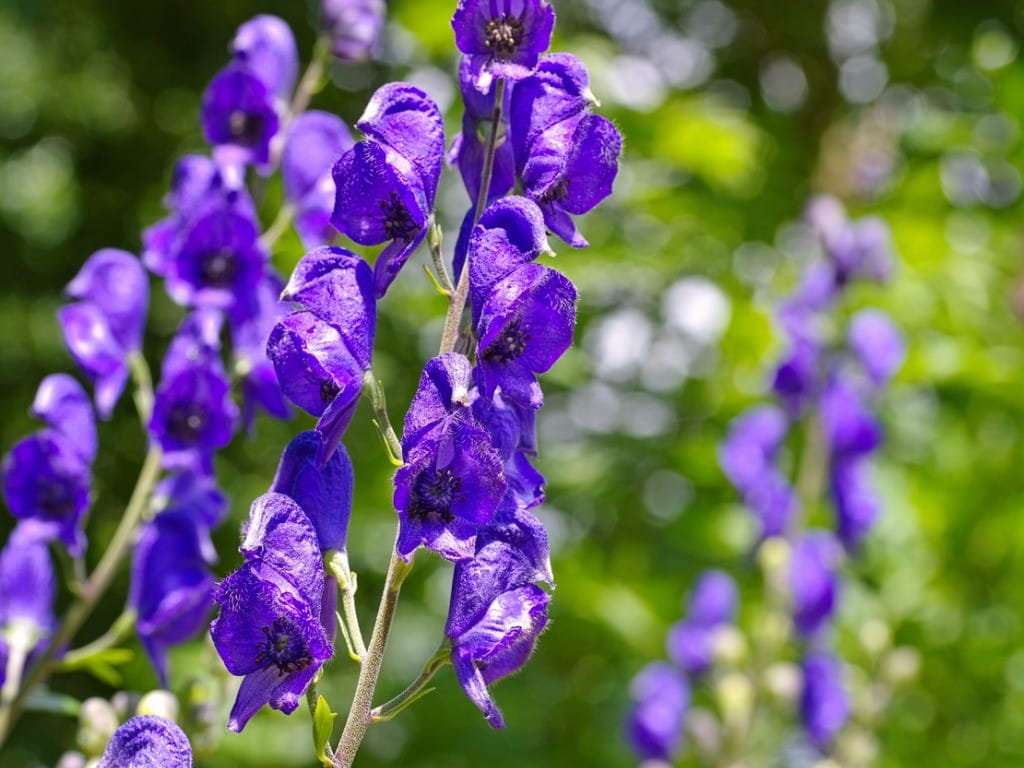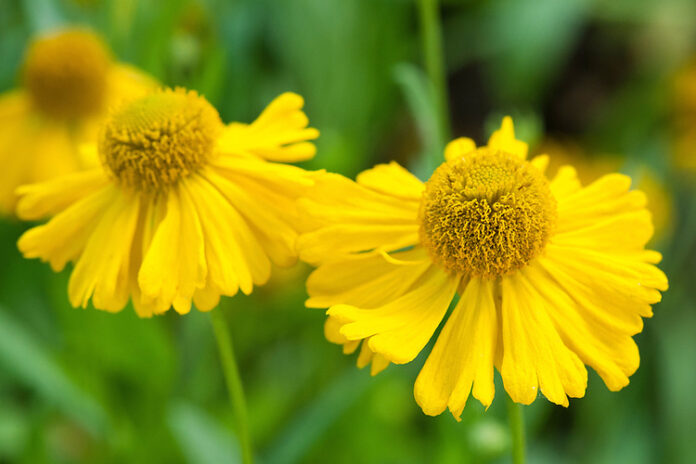[ad_1]
If you love late-season color but don’t want to plant many perennials that require extra work and attention, helenium is the answer. Heleniums are a diverse group of plants that can be herbaceous perennials or subshrubs. All have brilliant daisy flowers that attract butterflies, bees and other insects.
The colorful blooms appear from late summer through fall, depending on species and weather conditions. They provide color from September through November in most areas. Growing helenium is easy with the right information to guide you along the way.
Here’s what you need to know about how to grow and care for sneezeweed helenium in your garden.
Colorful Combinations of Helenium
Helenium features bright-green foliage that contrasts beautifully with velvety, daisy-like flowers in orange, yellow, dark red and golden brown shades. As a native to North America and southern Canada, this plant grows in moist, low lying meadows or at the edge of damp woodlands.
The plants are also characterized by lance-shaped foliage with stiff, upright stems. When planted in early summer, these plants grow quickly to a mature size of two to five feet tall and spread to 24 inches wide. The bloom time for this yellow star happens as early as June, but most flowers bloom in late summer to autumn.
The 1-2 inch wide flowers have a typical daisy pattern with ray florets surrounding the central disk flowers. In most heleniums, 11-21 ray flowers are short and wedge-shaped, but ‘Mardi Gras’ has 18-25 longer, strap-shaped ray flowers. The colors of the ray flowers range from pale or bright yellow to gold, warm orange, coppery brown, and deep red.
Caring for Helenium
Helenium plants are easy to grow from seeds or by dividing the clump after blooming. Grow in any sunny spot in average garden soil that drains well at planting time and then water thoroughly to set the roots deep into the ground. Below are the caring tips for this late-season plant:
Light
Heleniums grow in full sun or part shade but will flower better if they get at least six hours of direct sunlight. They will get leggy if they don’t get at least six hours of sun each day. They will also accept some afternoon shade, especially if your planting area is on a dry side.
Soil
This plant requires moist soil to wet soil, although many of its hybrids are more tolerant to drier soil. They also like soil on the acidic side with a soil pH of 5.5 to 7.0. So, test soil pH before you proceed.
Place them in an area where they’ll enjoy moist conditions and not in a boggy site. A rain garden site where moisture naturally collects is perfect for them, especially under low-lying areas and underneath downspouts. Even though well-draining soil is best, these plants are also clay tolerant.
Watering Heleniums
Heleniums will grow and flower best with an inch of rain per week. In extremely hot, dry weather, try spraying them with a mist of water every day. In the summer, you can pretty much expect to have to water them daily if there is no rainfall.
Many of these plants will die from being overwatered. They prefer dry soil, so only water them when the top of the soil is nearly dry to the touch. Adding a layer of organic mulch will also conserve moisture and maintain acidic soil pH.
Fertilizing Heleniums
If you choose to fertilize your Helenium plants, use a very low-nitrogen formula, which can encourage more foliage growth at the expense of flowers. This plant may benefit from fertilization in the early spring when growth resumes. They are not heavy feeders, and one application of a balanced flower fertilizer in the early spring will be fine.
Avoid overly rich soils, and excessive fertilization as this will promote rampant foliar growth and fewer flowers. Tall plants may need to be stalked to prevent flopping when they begin to bloom. Pinching back new growth in late spring will promote branching and bushy growth. Divide plants in the spring or fall every three to five years to keep plants vigorous.
Temperature and Humidity
Yellow star plants tolerate humidity and hot summers, but the proper spacing is important to prevent fungal diseases like mildew and rust in areas prone to humidity.
Uses of Helenium Plants
Heleniums are popular as cut flowers and for use in dried arrangements. They can sometimes be found as garden specimens, especially those with tall, mature heights such as the Helenium giganteum variety. Their common name, sneezeweed, comes from a long-lost use of the ground plant as a snuff ingredient. After inhaling, it’s believed that this plant can drive evil spirits from the body.
These late-season bloomers can be used in beds, cottage gardens, prairies, meadows, wild gardens, and naturalized areas. They can also be used in rain gardens
because they like moist soil. They also combine well in informal perennial, mixed beds and borders with ornamental grasses,
Varieties of Helenium
Butterpat Helenium (Helenium amarum)
Helenium autumnale Common sneezeweed or fall sneezeweed is another good choice for garden plants with its pure yellow flowers. It thrives in moist soils and full sun, which can be challenging to find where I live. It’s best to locate this plant in raised beds or along the edges of rain gardens. This variety grows with bright yellow ray flowers and a prominent yellow disc.

Double Trouble Helenium
This is another great variety of helen’s flower that has frilly bright yellow flowers with double petals. It spreads out into a nice, neat mound that blooms from mid-summer through early fall.
Salsa Helenium
This Mariachi salsa helenium autumnale is a dense, compact plant covered in bright orange and yellow blossoms beginning in late summer.
Dakota Gold Helenium
Dakota Gold helenium autumnale is a hearty variety with yellow petals and an orange center. It produces numerous blooms from July to September and is perfect for the garden, roadside park, or country estate.
Mardi Gras Helenium
This type of helenium bears 2-inch daisies in rich orange washed with yellow and red. They provide a stunning contrast to the dark green foliage. Its upright clumps may reach three feet tall.
Moerheim Beauty Helenium
The coppery red ray flowers of this plant surround a dark disk. This helenium variety sports large, heavily veined leaves.
Wiltraut
This is an old German variety with orange petals flecked with gold that has deep maroon veining. The large flowers appear over a long period of time and are popular with both gardeners and professional cut flower growers.
The Bishop Helenium
This rare German variety has bright yellow flowers that are about five inches across. The petals flare at the ends and nearly cover the maroon brown center disk. The blooms are very luscious looking, making them popular with gardeners like fresh cut flowers for floral arrangements.
Feueresiegel
Also known as a fiery lightning bolt, is one of the German nurserymen from Karl Foesrsters. These free-flowering plants have deep yellow flowers marked with fork streaks of red radiating from the light brown disk.
Helenium Companion Plants
Obedient Plant
This is named for the way flowers that are moved to the new position on the new stem stay in place. It produces showy, unusual flower spikes with little tubular flowers in white, pink, and purple. These square stems carry pairs of mid-green, lance-shaped foliage toothed along the edges. These plants tolerate moist soils but may become aggressive when given ample water and full sun.
:max_bytes(150000):strip_icc()/obedient-plant-1402852_05-cafe6ef9a3f748baa9ec215a5d16ce99.jpg)
Monkshood
This perennial plant has regal blue spires. Monkhood produces tall spikes of hooded purple, blue, white, and bicolor blooms in late summer to fall. It does well in partial shade, though it will grow well in full sun in cool climates. However, this plant dislikes hot weather, so it’s not great for gardeners in hot summer climates.

Daylily
You’ll find daylilies in ditches and fields because they’re so easy to grow. Its flowers are borne on leafless stems. Even though each bloom lasts a single day, superior cultivars carry several buds on each scape, so bloom time is long, especially if you deadhead daily.
FAQs on How to Grow and Care for Helenium Plants
Is a helenium plant easy to grow?
Helenium is easy to grow and can be quite striking in a garden. It comes in many colors and makes a good-cut flower. When you cut the stem, make sure that you leave at least ¼ inch of the stem above the ground to allow regrowth.
Is the helenium plant poisonous?
It is not poisonous. But it can irritate the skin. So you should take proper care when handling it.
What conditions are required to grow helenium?
The Helenium plant needs a sunny position but can be grown in light shade, though this may reduce the flowering season and number of flowers per scape. It prefers moist but well-drained soil. Plant it in rich, moist, but well-drained soil.
How does helenium grow?
Helenium grows as an herbaceous biennial or short-lived perennial flower that spreads by seeds and underground runners. As it can propagate vegetatively, you need not worry about its dying out soon.
Final Thought on How to Grow and Care for Helenium Plant
As you can see, the helenium plant is not difficult to grow and care for. It just needs the right amount of moisture, well-drained soil, and enough sunlight. If these are provided, they will naturally propagate themselves in your garden. You can also use stem cuttings or root division to increase its presence in your garden plot. This way, you’ll never run out of this lovely plant.
The post How to Grow and Care for Helenium [Sneezeweed] appeared first on Kitchen Infinity.
[ad_2]
kitcheninfinity.com










